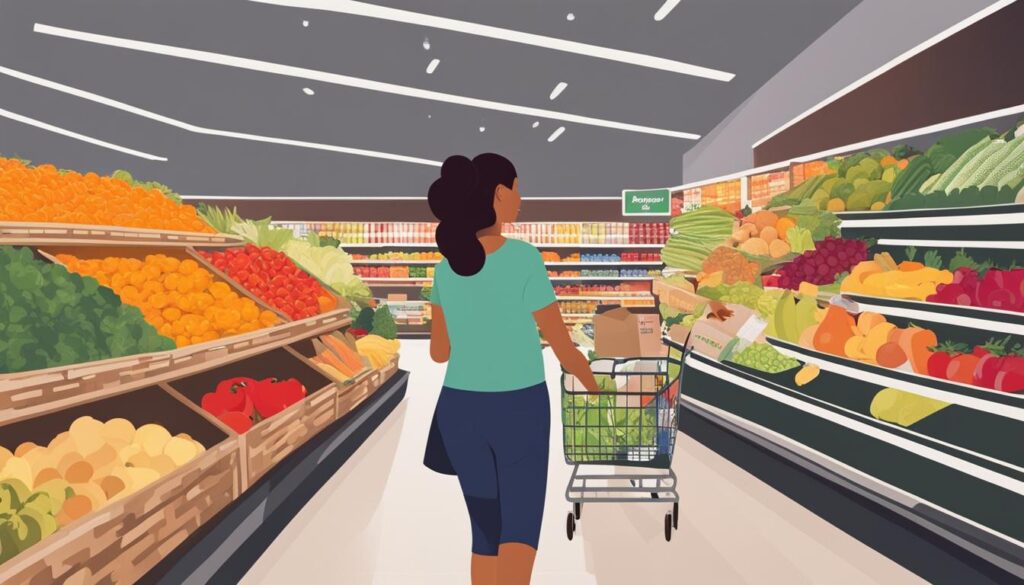We may earn money or products from the companies mentioned in this post.
Grocery shopping can be a daunting task, especially when you’re trying to make healthy choices, stay within budget, and save time. However, with the right strategies in place, you can transform your grocery shopping experience from a chore to a breeze. In this section, we will explore various effective Grocery Shopping Strategies that can help you optimize your grocery shopping experience. From smart tips to budget-friendly hacks, we will cover everything you need to know to master your grocery list like a pro.
Key Takeaways
- Effective grocery shopping strategies can help you optimize your shopping experience.
- Smart tips and budget-friendly hacks will help you make the most of your grocery list.
- You can save time and money by maximizing your resources.
- Healthy choices and sustainable shopping practices are possible with the right approach.
- By implementing these strategies, you can conquer the grocery store and make each shopping trip count.
Maximizing Your Time and Money
Effective grocery shopping involves more than simply wandering the aisles and filling your cart. With these smart grocery shopping tips and time-saving grocery shopping tactics, you can make the most of every trip and streamline the process to save both time and money.
Creating Efficient Shopping Lists
The key to saving time and staying organized is to create a detailed shopping list before you head to the store. By planning out your meals and making a list of the ingredients you need, you can avoid wandering aimlessly and overspending. Consider organizing your list by category, such as produce, dairy, and frozen foods, to make navigating the store even easier.
Tip: Keep a running list on your phone or in a notebook in your kitchen so you can add items as you run low or run out.
Utilizing Technology
In this digital age, there are plenty of tools available that can help simplify your grocery shopping experience. Consider downloading a grocery list app, such as AnyList or Out of Milk, that allows you to create and share lists with family members. Many grocery stores also offer online ordering and curbside pickup or delivery, which can save time and eliminate the need to navigate crowded stores.
Avoiding Common Pitfalls
One common mistake that can lead to overspending and wasted time is shopping while hungry. Before you head to the store, be sure to eat a snack or meal to avoid impulse purchases. Additionally, be wary of sales and specials that may not actually save you money in the long run. If a deal requires you to buy more than you need or purchase a product you don’t typically use, it may not be worth it.
Grocery Shopping Tips and Tricks
Here are a few additional grocery shopping tips and tricks that can help you save time and money:
- Shop the perimeter of the store, where fresh produce and other whole foods are typically located.
- Compare prices by weight or unit rather than just looking at the overall price.
- Consider purchasing store-brand products, which are often just as good as name-brand items but cost less.
- Buy in bulk for items that you use frequently, such as rice or pasta.
By utilizing these strategies and incorporating them into your grocery shopping routine, you can become a pro at maximizing your time and money while nourishing your body with healthy choices.
Nourishing Your Body with Healthy Choices
When it comes to making healthy choices at the grocery store, it’s important to have a plan. Here are some strategies to help you prioritize your health:
Read Labels
One key step in choosing healthier options is to read the nutrition labels. Pay attention to the serving size, calories, ingredients, and the amounts of fat, sodium, and sugar. Try to choose products with fewer artificial ingredients, added sugars, and trans fats.
Select Fresh Produce
Incorporating fresh fruits and vegetables into your meals is an excellent way to boost your overall health. Look for a colorful variety of produce to ensure you’re getting a range of vitamins and minerals. Choose in-season produce for optimal freshness and flavor.
Incorporate Nutritious Options into Meal Planning
Meal planning can be a helpful tool for ensuring you have nutritious meals throughout the week. Aim to include a source of protein, healthy fats, and complex carbohydrates in each meal. Consider batch-cooking and prepping ingredients in advance to save time and reduce food waste.
Compare Prices and Quality
Healthy options don’t have to break the bank. Compare prices and quality of similar products to help you make the best decision for your budget and health. Consider buying generic or store-brand products, as they can often be just as nutritious as name-brand items.
Try New Recipes and Ingredients
Experimenting with new recipes and ingredients can be a fun way to incorporate healthy options into your meals. Look for recipes that utilize whole grains, lean protein, and fresh produce. Consider trying new fruits and vegetables or swapping out less healthy ingredients for healthier options.
“The food you eat can be either the safest and most powerful form of medicine or the slowest form of poison.” – Ann Wigmore
By implementing these healthy grocery shopping tactics, you can prioritize your health and nourish your body with nutritious options.
Budget-Friendly Shopping and Sustainable Choices
Grocery shopping on a budget doesn’t have to mean sacrificing quality or sustainability. By incorporating a few simple strategies into your shopping routine, you can save money and support eco-friendly practices.
Budget-Friendly Shopping
To save money on groceries, start by creating a meal plan and shopping list for the week. This helps you avoid impulse buys and ensures you only purchase items you’ll actually use. Look for sales and coupons on items you know you’ll need, and consider buying in bulk for non-perishable items. Generic or store-brand options can also be a cost-effective alternative to name-brand products.
Check the unit price to ensure you’re getting the best deal per quantity, and note that buying fresh produce in season can be cheaper than out-of-season options. Finally, consider shopping at discount retailers or farmers markets for additional savings.
Sustainable Choices
Shopping sustainably means purchasing products that prioritize the health of the planet and its inhabitants. To shop sustainably:
- Bring your own reusable bags to reduce plastic waste
- Choose products with eco-friendly packaging or packaging that is easily recyclable
- Support local and organic products, which have a lower carbon footprint and often support small businesses
- Minimize food waste by only purchasing what you need and opting for imperfect produce that might otherwise go to waste
Another way to shop sustainably is to consider reducing your consumption of animal products, which have a larger environmental impact than plant-based options. Even small changes, such as choosing one vegetarian meal a week, can make a difference.
Table: Comparison of Sustainable and Unsustainable Products
| Product | Sustainable Option | Unsustainable Option |
|---|---|---|
| Cotton T-Shirt | Organic cotton, fair trade production | Conventional cotton, produced with harmful pesticides and labor practices |
| Beef | Grass-fed, local, sustainably raised | Factory-farmed, antibiotic-laden, with a larger carbon footprint |
| Cleaning Products | Eco-friendly, plant-based ingredients, reusable packaging | Conventional, chemical-laden, single-use packaging |
By using both budget-friendly and sustainable shopping strategies, you can save money while supporting the health and well-being of the planet. Small changes can make a big impact, and with a bit of effort, you can create a shopping routine that benefits both your wallet and the environment.
Conclusion
Congratulations! You have now learned valuable strategies for optimizing your grocery shopping experience. By implementing these tips and tricks, you can save time, money, and prioritize your health while shopping for groceries.
Remember to create efficient shopping lists and utilize technology to make the most of your time. Read labels and select fresh produce to incorporate healthy choices into your diet. Plan meals, utilize coupons, and support local and eco-friendly products while shopping on a budget.
Keep in mind that sustainability is equally important when it comes to grocery shopping. Reducing food waste by planning meals and supporting eco-friendly products can make a significant impact on the environment.
With these effective grocery shopping strategies, you can master your list like a pro and make the most of every shopping trip. Use the knowledge and tools provided in this article to conquer the grocery store and take control of your shopping experience today!
FAQ
What are some effective grocery shopping strategies?
Effective grocery shopping strategies include creating a shopping list, planning meals in advance, comparing prices, and shopping during non-peak hours.
How can I save time and money while grocery shopping?
Some tips to save time and money include utilizing technology to create digital shopping lists, shopping in bulk, and taking advantage of coupons and discounts.
How can I make healthier choices when grocery shopping?
To make healthier choices, read product labels, prioritize fresh produce, and incorporate nutritious options into your meal planning.
What are some budget-friendly and sustainable grocery shopping strategies?
Budget-friendly and sustainable strategies include meal planning, using coupons, reducing food waste, and supporting local and eco-friendly products.
What will the conclusion of this article cover?
The conclusion will summarize the key points discussed throughout the article and encourage readers to start implementing the effective grocery shopping strategies learned.
Affiliate Disclosure: This post may contain affiliate links. If you purchase through our link, we may receive a small commission, but at no additional cost to you. For more information, please see our Disclosure statement.


